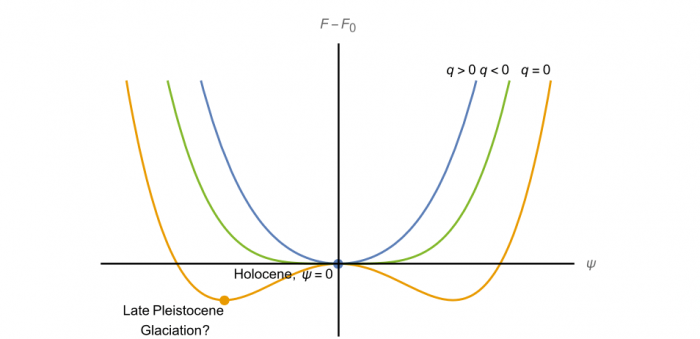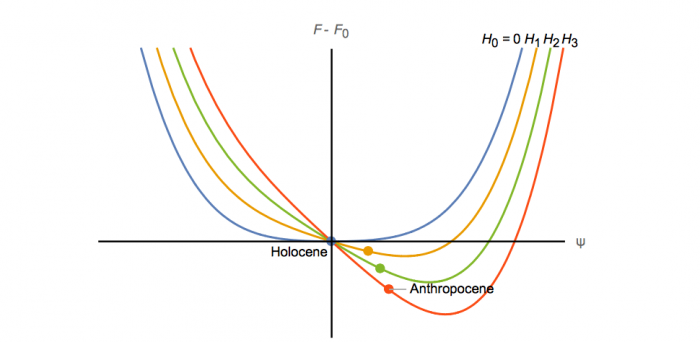
The Anthropocene represents an entirely new epoch in the history of the Earth System. Evidence shows that the evolution of Earth is now determined mostly by the influence of human activities, rather than the natural astronomical and geophysical forces, q, that were dominant until the most recent past.
Furthermore, we are witnessing a great acceleration in the changes caused by human factors. These lead to conditions that are in stark contrast with the remarkable climatic stability of the twelve millennia since the end of the last glaciation, an epoch called the Holocene. This implies that the Earth System was in an equilibrium state that was disturbed by the increasing human influence in the environment.
We propose that the transition from the Holocene to the Anthropocene is, in fact, a phase-transition, a qualitative change in the features of the equilibrium state of the Earth System. We also provide a physical model based on the Landau-Ginsburg theory, a theoretical setup to describe all phase transitions.
This model allows one to obtain the free energy, F, of the system, the relevant thermodynamic quantity and leads to the identification of the two different phases resulting from the transition and their different equilibrium points. The key quantity to be defined is the order parameter, ψ, that we here consider as a function of the temperature.

Fig. 1. Earth System equilibrium when driven only by natural forces, q. All systems tend to minimize their free energy. Credit: Orfeu Bertolami
The Landau-Ginzburg formulation then allows us to study the impact of an additional influence on the Earth System, in this case, the effects of human activities, modeled as an external field, H. The effect is immediately visible in the destabilization of the Holocene conditions, setting the Earth System on a path towards a new, yet unknown equilibrium state. We are also able to compute a susceptibility parameter that shows how the effects of the external field are much greater when the system is close to the phase transition. This is equivalent to saying that there is a tipping point at the phase transition.

Fig. 2. Earth System free energy with increasing values of human activity effects, H. The equilibrium point further departs from the Holocene stability towards higher temperatures. The Anthropocene is a non-equilibrium state where the ES is moving towards a new yet undetermined equilibrium. Credit: Orfeu Bertolami
The goal of setting up this theoretical framework is that it can be fed the existing and future data on the conditions of the Earth system and its various subsystems and build a multidimensional predictive model for the Anthropocene. We have already exemplified how this can be performed through a single parameter, the biomass depletion, and how the model can be constrained from the data in order to provide numerical predictions.
This is the path ahead in the development of this new theory. Hopefully, it will provide a new tool for the understanding and for the search of solutions to the man-made climate change. As the importance of human activities keeps increasing, so will their destabilizing influence on the Earth system and its evolution towards the new equilibrium point away from the Holocene. It is already clear that only through a drastic change in the current socio-economic system will humankind be able to avert the menacing implications of the Anthropocene.
These findings are described in the article entitled A physical framework for the Earth System, Anthropocene Equation and the Great Acceleration (Volume 169, pages 66-69, October 2018), recently published in the journal Global and Planetary Change. This work was conducted by O. Bertolami and F. Francisco from the Universidade do Porto.









